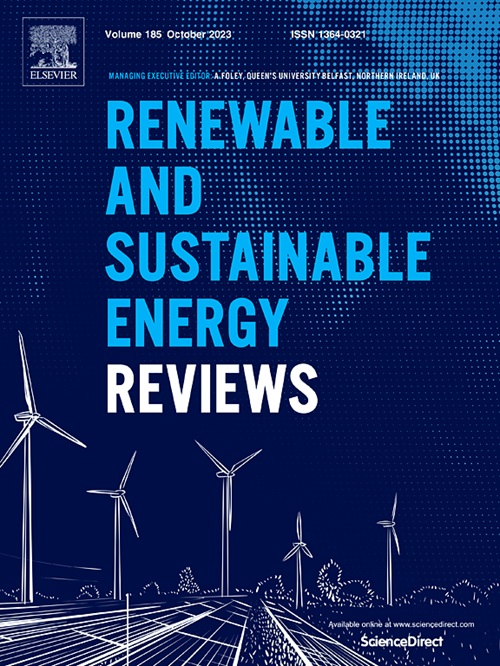海上浮动可再生能源技术的共享系泊:综述
IF 16.3
1区 工程技术
Q1 ENERGY & FUELS
引用次数: 0
摘要
浮动海上可再生能源(FORE)产业的下一个前沿是开发由设备阵列组成的大型农场。为了降低资本支出和安装成本,已经提出了共享系泊系统,其中锚(和系泊线的一部分)在相邻设备之间共享。然而,由于在浅水和深水中表现出不同的挑战,该行业对共享系泊和锚的适应持谨慎态度。浅水区的共享系泊/锚容易受到复杂环境条件下的瞬时载荷的影响,而深水系泊/锚本身结构复杂,容易受到峰值锚载荷的影响。本文的目的是对FORE行业内的共享系泊/锚进行全面审查,特别强调浮动风能,太阳能和波浪能部门。共享系泊的出现可以追溯到传统海上工业(如油气和/或水产养殖)的智慧。此外,还提供了在浅水和深水中安装的典型FORE技术的共享系泊系统类型的评估。详细介绍了设备特定配置,提出了在每个FORE部门采用共享系泊的范围。接下来是行业确定的各种重点领域,相应的学术研究成果和新出现的知识差距的综合总结。基于研究结果,本综述确定了开发更高保真度的未来设计工具的需求,以加速FORE行业共享系泊和锚的应用。本文章由计算机程序翻译,如有差异,请以英文原文为准。
Shared moorings for floating offshore renewable energy technologies: A review
The next frontier in the floating offshore renewable energy (FORE) industry is the development of large-scale farms comprising arrays of devices. With the goal of reducing the CAPEX and installation costs, shared mooring systems where anchors (and a part of the mooring line) are shared between adjacent devices, have been proposed. However, the industry is prudent towards adaptation of shared moorings and anchors due to a number of challenges which manifest differently in shallow and deep water. Shared moorings/anchors in shallow waters are susceptible to snap loads stemming from complex environmental conditions whilst the deep-water counterpart is, in and of itself, structurally complex and susceptible to peak anchor loads. The aim of this paper is to present a comprehensive review of shared moorings/anchors within the FORE industry with particular emphasis on the floating wind, solar and wave energy sectors. The advent of shared moorings is traced back to the wisdom perceived from conventional offshore industries such as O&G and/or aquaculture, respectively. In addition, an appraisal of the types of shared mooring systems for canonical FORE technologies installed in shallow and deep water is provided. A detailed presentation of device-specific configurations which brings forth the scope for adoption of shared moorings in each FORE sector is provided. This is followed by a comprehensive summary of various thrust areas identified by the industry, the corresponding academic research effort and the emerging knowledge gaps. Based on the findings, the present review identifies the need for developing higher-fidelity futuristic design tools to accelerate the application of shared moorings and anchors by the FORE industry.
求助全文
通过发布文献求助,成功后即可免费获取论文全文。
去求助
来源期刊

Renewable and Sustainable Energy Reviews
工程技术-能源与燃料
CiteScore
31.20
自引率
5.70%
发文量
1055
审稿时长
62 days
期刊介绍:
The mission of Renewable and Sustainable Energy Reviews is to disseminate the most compelling and pertinent critical insights in renewable and sustainable energy, fostering collaboration among the research community, private sector, and policy and decision makers. The journal aims to exchange challenges, solutions, innovative concepts, and technologies, contributing to sustainable development, the transition to a low-carbon future, and the attainment of emissions targets outlined by the United Nations Framework Convention on Climate Change.
Renewable and Sustainable Energy Reviews publishes a diverse range of content, including review papers, original research, case studies, and analyses of new technologies, all featuring a substantial review component such as critique, comparison, or analysis. Introducing a distinctive paper type, Expert Insights, the journal presents commissioned mini-reviews authored by field leaders, addressing topics of significant interest. Case studies undergo consideration only if they showcase the work's applicability to other regions or contribute valuable insights to the broader field of renewable and sustainable energy. Notably, a bibliographic or literature review lacking critical analysis is deemed unsuitable for publication.
 求助内容:
求助内容: 应助结果提醒方式:
应助结果提醒方式:


